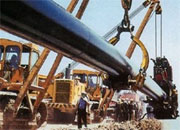By now, 30 kilometers of the offshore section, that is approximately one-fifth of the pipeline’s total length (159.5 kilometers), have been welded and placed.
The entire construction process, i.e. pipe welding, seam quality inspection, joints flashing and pipeline placement on the sea bottom, is being performed by the C-Master pipe-laying barge on a round-the-clock basis. Special-purpose vessels continuously deliver pipes from the onshore supply base.
The pipeline engineering and construction operations were arranged in such a way that ensured maximum mitigation of the environmental impact on the Black Sea ecosystem. In particular, the pipeline route was selected with due regard to the seafloor features. Prior to the construction operations, various polluting objects were removed from the pipeline route.
Considerable mitigation of the environmental impact on vulnerable coastal ecosystems is achieved through the most suitable coastal line crossing procedure – horizontal directional drilling. In addition, the crossing wells are equipped with special earthquake protection devices.
The Bigfoot I pipe-laying barge will perform the pipeline construction in shallow waters and connect the offshore section to the crossing elements.
The Dzhubga – Lazarevskoye – Sochi gas pipeline has been included into the Program approved by the Russian Federation Government and aimed at construction of the Olympic facilities and development of Sochi as a mountain-climatic resort.
The gas pipeline will stretch 177 kilometers including a 159.5-kilometer offshore section. The pipeline route will run on the Black Sea bottom along the coastal line (around 4.5 kilometers away from the coast) to the Kudepsta gas distribution station near Sochi.
The gas pipeline landfalls will be located near Dzhubga, Novomikhailovskoye, Tuapse and Kudepsta.
The 530-millimeter pipeline will have the annual throughput capacity of some 3.8 billion cubic meters.
The gas pipeline construction was launched in September 2009. It is being carried out in a most climatically attractive and, therefore, the most cherished region of the country, the Caucasian coast of the Black Sea. In this context, Gazprom pays great attention to the environmental activities to be taken during the pipeline construction.
The construction schedule was worked out with due regard to the most important biocycles of the local fauna species, which is greatly important for the animal ecosystem preservation. The offshore option of the pipeline route has minimized allocation of industrial, agricultural and forest lands, as well as specially protected natural reservations.
It is planned to finish the gas pipeline construction in the second quarter of 2010.
13 Декабря 2025 | суббота | 09:57


